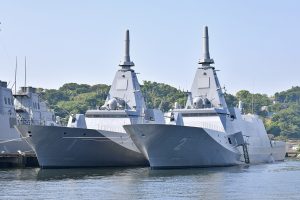On August 31, the Ministry of Defense in Tokyo asked for 7.74 trillion yen ($53 billion) for fiscal year 2024, its largest ever budget request, as Japan faces the most severe and complex security environment since the end of World War II.
The request, a whopping 13.4 percent increase from the initial budget in the current fiscal year, is the 12th consecutive rise. The trend started when late Prime Minister Abe Shinzo, who adopted a tougher stance against North Korea and China, returned to power in December 2012. Current Prime Minister Kishida Fumio – who like Abe, belongs to the Liberal Democratic Party (LDP) – has vowed to “fundamentally reinforce Japan’s defense capabilities within the next five years.”
The budget request will be sent to the Finance Ministry to consider before a decision is made in late December. It is almost certain that next year’s budget will be the largest ever, marking the 10th consecutive year of a record-high defense budget.
The budget plan lists seven key pillars of “necessary efforts to drastically strengthen Japan’s defense capabilities.”
Those are: (1) “stand-off defense capabilities,” such as mass production of longer-range missiles; (2) “comprehensive air and missile defense capabilities” to deal with various missiles; (3) “unmanned asset defense capabilities” such as the use of drones; (4) “cross-domain operational capabilities” in space, cyberspace, and electromagnetic domains; (5) “command and control and intelligence-related functions”; (6) “maneuvering and deployment capability” to send troops and supplies to the front line of a conflict; and (7) “sustainability and resiliency.”
As for the first pillar, the ministry asked for 755.1 billion yen ($5.18 billion) to develop and produce a range of homegrown stand-off missiles to acquire counterstrike capabilities against enemy bases. That follows through on a decision made in December for Japan to pursue a long-range strike capability, as reflected in the new National Security Strategy.
On the second pillar, the Defense Ministry requested 1.27 trillion yen for strengthening the nation’s Integrated Air and Missile Defense (IAMD), a system already adopted by the U.S. military, to counter the growing airborne threats posed by China, North Korea, and Russia.
The ministry’s Acquisition, Technology, and Logistics Agency (ATLA) requested 72.6 billion yen to push ahead with its next-generation fighter program in partnership with the United Kingdom and Italy. It plans to continue developing a basic design of the future fighter’s fuselage and the detailed engineering of its engines.
ATLA also asked for 18.4 billion yen to domestically develop a new medium-range air-to-air guided missile to be installed in the next-generation fighter, which is set to be the successor to the Japan Air Self-Defense Force’s F2 fighter jet.
The JASDF requested 107.7 billion yen to buy eight more Lockheed Martin F-35A Lightning II joint strike fighters and 125.6 billion yen to purchase seven more F-35B Lightning multirole fighter aircraft.
The Japan Maritime Self-Defense Force (JMSDF) asked for 379.7 billion yen to build two Aegis system-equipped vessels, which are alternatives to Japan’s now-scrapped plan for a land-based Aegis Ashore ballistic missile defense system. The ministry expects the total construction cost for each vessel to reach 395 billion yen.
The JMSDF also requested 174.7 billion yen to build two new multirole frigates, called “New FFM,” in Tokyo.
The Defense Ministry said it will acquire a total of 12 new FFMs that will succeed the Mogami-class FFM for the JMSDF in coming six years while building two new ships in one year. The New FFM has a standard displacement of 4,500 tons, while the Mogami class has a standard displacement of 3,900 tons.
Although the new warship class will be heavier and larger than the Mogami class, defense officials said the new class’s crew complement will be only 90, the same as that of the Mogami class.
The JMSDF had originally planned to build a total of 22 Mogami-class frigates as Tokyo ramps up efforts to strengthen the country’s naval forces.
However, it has decided to now procure a total of only 12 such frigates until 2023, with plans to construct a new class of 12 warships from 2024. The new frigates will essentially be improved Mogami-class ships.
The Defense Ministry said the new-class FFM will be fitted with longer-range missiles, enhanced anti-submarine capabilities, and improved capabilities for various maritime operations.
The JMSDF also asked for 42.3 billion yen to continue modifying its two Izumo-class helicopter carriers – JS Izumo and JS Kaga – into aircraft carriers capable of enabling Lockheed Martin F-35B fighter aircraft operations.
The JMSDF said both ships will complete all necessary upgrades to become light aircraft carriers operating F-35B fighters in fiscal year 2027.
Meanwhile, the Japan Ground Self-Defense Force (JGSDF) strives to strengthen security efforts in response to emergency contingencies in areas surrounding Japan, particularly in the Nansei Islands, with China in mind.
It requested 17.3 billion yen to procure three maneuverable boats during the next fiscal year in an effort to secure capabilities for swift and reliable transportation of necessary units to defeat an invasion of Japan’s southwestern islands. The Defense Ministry said the boats will be 35 meters long.
Looking ahead, with Japan’s government debt already standing at more than 260 percent of GDP – the highest in the world and twice that of the United States – there should be a strict limit as to how much Tokyo adds to its ballooning national deficit in an attempt to match China’s increasing military might. This will further make Tokyo rely on liberal democratic like-minded nations such as the U.S., Australia, U.K., Italy, and South Korea for its national security.

































